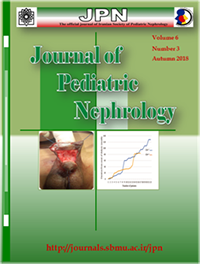Prevalence of Nephrolithiasis in 7-11 year-old Students: A Multicenter Study
Journal of Pediatric Nephrology,
Vol. 6 No. 3 (2018),
19 February 2019
,
Page 1-4
https://doi.org/10.22037/jpn.v6i3.23775
Abstract
Introduction: Renal diseases can be asymptomatic even in progressive disorders; therefore, detecting urine and ultrasound abnormalities may help facilitate early diagnosis and prevention of renal diseases. This study was conducted to investigate random urine parameters and urinary system ultrasonography findings in 7-11 year-old students.
Materials and Methods: Healthy students from Tehran and Qom, Iran were enrolled in a prospective descriptive study and their sex, age, weight, height, and BMI were measured. Then, a fresh clean urine sample was collected and ultrasonography of the urinary tract was done. The urine specimen was tested for urine Ca/Cr, urine oxalate/Cr, and urine citrate/Cr.
Results: Of 932 students, 47.9% were female and 52.1% were male. The age range of the students was 7-11 years with a mean age of9.08 years. A history of renal disease and UTI was positive in 1.1% and 9.9% of the students, respectively. Ultrasound was normal in78% and abnormal in 22% of the students. Abnormal findings included hydronephrosis in 1.1%, fullness of the urinary tract in 0.1%, urinary system duplication in 3%, urolithiases in 0.7%, decreased kidney size in 0.4%, increased bladder thickness in 8.9%, and other abnormal findings in 7.8% of the subjects. Abnormal urine findings included hypercalciuria, in 10.9%, urine hyperuricosuria in 5.4%, urine hyperoxaluria in 12.8%, and hypocitraturia in 96.9% of the students.
Conclusions: According to the results, nephrolithiasis may be due to hyperoxaluria, hypercalciuria, and hyperuricosuria in a normal population. Genetics and nutrition are more important risk factors. Therefore, some nutritional interventions for decreasing urine oxalate, calcium, and uric acid may be beneficial.
Keywords: Urinalysis; Ultrasonography; Hypercalciuria; Hyperuricosuria; Hyperoxaluria; Child.
How to Cite
References
Robert M, Kliegman MD, Bonita F, Joseph W. St Geme, Nina F. Schor REB. No Title. 20th edition. 2016.
Jafari Nodoshan AAH, Shajari A, Golzar A, Shakiba M. Urinary screening in primary school children in yazd, iran. Shiraz E Med J. 2015;16(1):1–4.
Safaeian B, Alaee E, Ariannejad S, Behnampoor N, Alizadeh S, Hasheminejad R, et al. The urine level of calcium to creatinine ratio in children suffering from urolithiasi. J Maz Univ Med Sci. 2013;23(108):77–81.
Akhavan-Sepahi M, Sharifian M, Mohkam M, Vafadar M, Hejazi S. Biochemical risk factors for stone formation in healthy school children. Acta Med Iran [Internet]. 2012;50(12):814–8. Available from: http://www.embase.com/search/results?subaction=viewrecord&from=export&id=L368169532%5Cnhttp://sfx.umd.edu/hs?sid=EMBASE&issn=00446025&id=doi:&atitle=Biochemical+risk+factors+for+stone+formation+in+healthy+school+children&stitle=Acta+Med.+Iran.&title=Acta+
Abdinia B, Mohkam M, Karimi A, Alikhah F. Prevalence rate of urinary tract infection and disorder of urinary profiles in the 7-12 years old healthy children in Tabriz, Iran. Arch Pediatr Infect Dis. 2013;1(3):122–5.
Celiksoy MH, Yilmaz A, Aydogan G, Kiyak A, Topal E, Sander S. Metabolic disorders in Turkish children with urolithiasis. Urology. 2015 Apr;85(4):909–13.
Mohkam M, Karimi A, Gharib A, Daneshmand H, Khatami A, Ghojevand N. Ceftriaxone associated nephrolithiasis: A prospective study in 284 children. Pediatr Nephrol. 2007;22(5):690–4.
Ceran O, Akin M, Akturk Z, Ozkozaci T. Normal urinary calcium/creatinine ratios in Turkish children. Indian Pediatr. 2003 Sep;40(9):884–7.
Sorkhi H, Aahmadi MH. Urinary calcium to creatinin ratio in children. Indian J Pediatr. 2005;72(12):1055–6.
Honarpisheh A, Hooman N, Taghavi A. Urinary Calcium Excretion in Healthy Children Living in. 2009;19(2):154–8.
Vehaskari VM, Rapola J. Isolated proteinuria: Analysis of a school-age population. J Pediatr [Internet]. 1982 Nov 1;101(5):661–8. Available from: http://dx.doi.org/10.1016/S0022-3476(82)80287-4
Valley K, Method UD, Malla HA, Bhat AM, Shazia B, Rather FA, et al. of Kidney Diseases and Transplantation Renal Data from Asia – Africa Prevalence of Proteinuria in School Children ( Aged 12 – 14 Years ) in. 2016;27(5):1006–10.
Avner ED, Harmon WE, Niaudet P, Yoshikawa N, Emma F, Goldstein SL. Pediatric Nephrology. 7th Edition, 2016.
- Abstract Viewed: 230 times
- PDF Downloaded: 122 times

